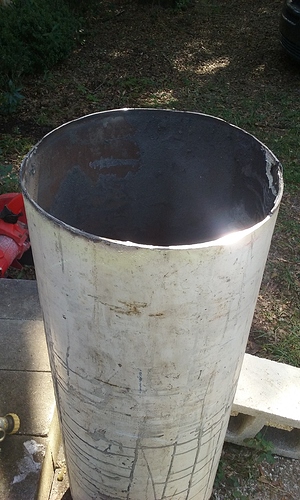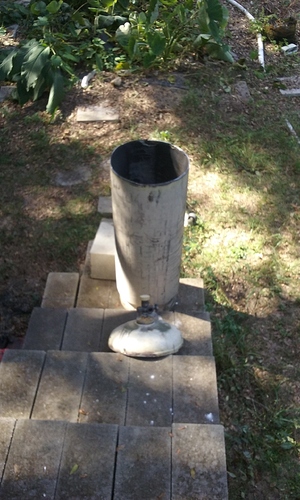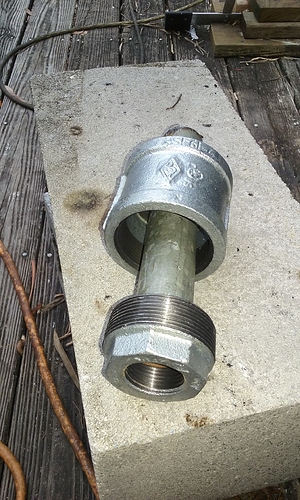thank you for the answer
if “puffer lid” was incidental to coal gasifier would be even simpler
you seem to consider that the “puffer lid” is very important on the filter? (on the ford ranger )
Thierry
I must admit I was terrified of cutting into this I did fill it full of water, dumped the water and put in the baking soda and vinegar, then put the cap back on. Nice to be in one piece. 
Hey, Mart,
As we say around here, looks good from my house. Seriously though, with a little practice following the line with the edge of the blade, you’ll get better. If you find yourself going off your line, STOP. Restart the cut on your line or wherever your reference is. If you keep going it will take longer to come back to the line as I think that’s what happened at the back edge of the tank where there is a slight dip away from straight. Yeah, I see it. Been there. In general it does look like a pretty good cut for your first try. Far better than my ragged gas cuts were. I also started using the thin .045" steel/SS blades from Dewalt. I use more, but I stray less which means less filling in with weld later.
If you noticed in the last pic of my above post I welded a cut off top section of the tank to a short straight section of the tank with a flange. Talk about a duh moment! Had I known where I was going, lol, I would have left the original top on, cut the feed hole and then cut out the larger “lid” from another tank using the grinder with a thin blade. The hole is 3" smaller diameter than the lid, so plan accordingly. I would now use a bigger feed hole and lid. Check (with a flat piece of plywood,etc) to see how far off your cut is. You might find it easier and a lot less work to add the flange and fill in the dips with weld rather than trying to flatten out the entire cut edge to get it straight. You’ve got to weld it anyway.
Did you ever feel (like I did) that backing up was the normal progression of things???
Pepe
Edit: Fellow gasifier enthusiasts, I want to add that I always try to cut to the outside of the line (in the waste area, if you will) and usually about 1" deep. Too shallow and the cut will tend to “wobble”, too deep and your response time to off cuts is longer and the miscut is longer. You’ll feel the sweet spot for the cut. I set the depth, line the blade up parallel to the ref. plane., hold the saw in place and lower the blade slowly all the way into the metal before moving forward. When doing this the blade will be following the line backward until it gets 1" deep. During this time it’s critical to lineup the cut. Now push forward slowly (you’ll have to get a feel for this) leaving the line. The other advantage with cutting to the line is that it leaves the line, so you have 2 points to judge your direction of cut. The front edge of the saw blade and the rear edge of the saw blade should both be just outside the line. If you start straight you have a good chance to keep the cut going straight. Have a stable setup to cut on. The cutting is slow, do not rush it, you’ll be glad you didn’t.
I have a method that I like to use for laying out square cut lines on round material. For smaller objects I will use a piece of heavy paper longer than the circumference of the object, wrap it tightly around, and adjust it till the overlap meets square. For larger objects such as propane tanks, I use light sheet metal. The strip should be probably 6 - 8" wide, 29 ga. Tighten with a ratcheting or cam lock strap, mark line and cut by method of choice.
I have access to sheet metal and a shear at my work, but it would probably be worthwhile to have a piece sheared at a shop, (or get one of their scrap pieces). It makes for accurate and straight layouts.
Regards, Garry
I wasn’t sure if the steel gauge system was used in Europe - it must be fairly universal even if not declared specifically, as the sheet metal trade and manufacturing processes are global. The numbered gauge system is very useful for those working with sheet metal, as each gauge has a distinct weight and mechanical properties.
http://www.custompartnet.com/sheet-metal-gauge
Sorry for any confusion - 29ga will be .0135", or .343mm. Slightly thicker if galvanized. I wouldn’t want to use 30 ga, as it might buckle, a bit heavier would be ok, but it will start to get unyielding for the application after about 26ga. Obviously diameter will dictate.
Regards, Garry
Garry,
Thanks for the tip on accurately marking round objects. I would have never thought of this. In the past, no matter how many times I try to measure, there is rarely a good reference point to measure from that is precise all the way around the tank. I sometimes have less than desirable results. I’ve done alot af grinding to true up the surfaces using a straight edge between both pieces before welding them together. Very good information!
Thanks again,
Bryan
Here is another way to remove the one inch pipe. It requires welding a merchant couple to a three inch cap. Then welding a three inch nipple to the tank wall.
Gary from PA
I really like the way he did the lid.



